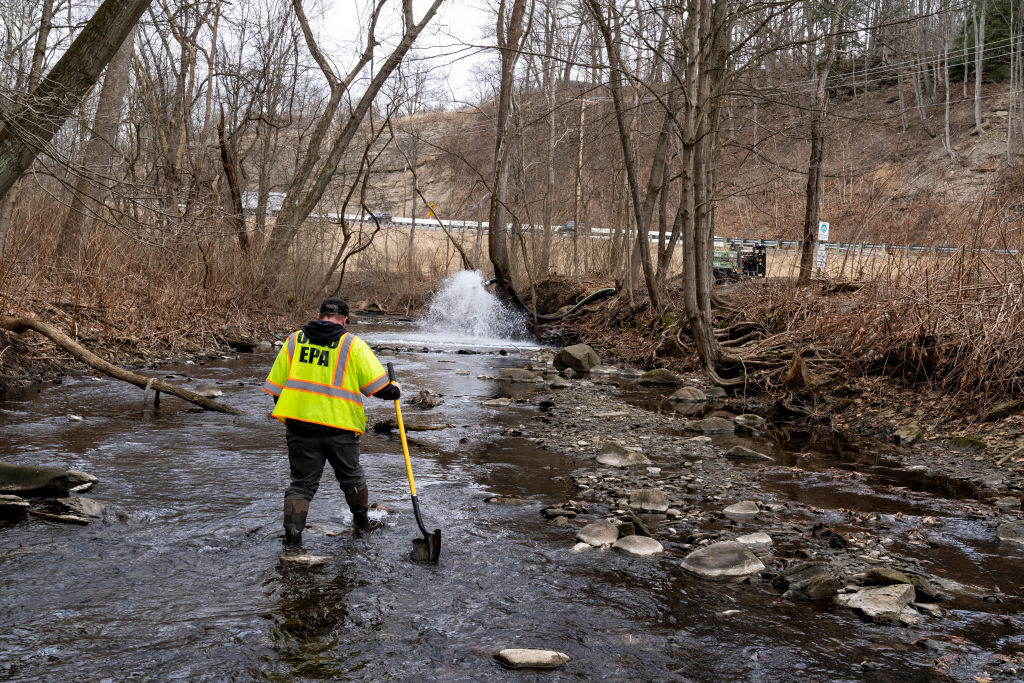Toxic Chemicals From Ohio Derailment: Months-Long Lingering Effects

Table of Contents
Immediate and Ongoing Health Concerns from Ohio Derailment Chemicals
The release of toxic chemicals in East Palestine has led to a range of immediate and ongoing health concerns for residents. Exposure to these hazardous substances, including vinyl chloride, butyl acrylate, and ethylhexyl acrylate, has resulted in a variety of symptoms.
Respiratory Issues
Residents have reported a significant increase in respiratory problems since the derailment. Many are experiencing:
- Increased asthma attacks and exacerbations of pre-existing conditions.
- Cases of bronchitis and other respiratory infections.
- Persistent coughing, wheezing, and shortness of breath.
- Concerns exist regarding the potential for long-term lung damage due to prolonged exposure to these toxic chemicals. The lack of sufficient long-term health monitoring adds to these concerns. While some initial reports indicated a surge in respiratory illnesses, comprehensive data on the long-term impact is still being gathered.
Neurological Effects
Exposure to the toxic chemical cocktail released in East Palestine raises significant concerns about potential neurological effects. Chemicals like vinyl chloride are known neurotoxins, capable of causing:
- Headaches and migraines.
- Dizziness and vertigo.
- Cognitive impairment, including difficulties with concentration and memory.
- The potential for long-term neurological damage remains a significant concern, and further research is needed to fully assess the extent of these risks. Studies on the long-term neurological effects of similar chemical exposures can provide crucial insights.
Reproductive and Developmental Concerns
The reproductive and developmental health of residents, particularly pregnant women and children, is a major concern following the Ohio derailment. Many of the released chemicals are known endocrine disruptors and teratogens, posing potential risks of:
- Birth defects.
- Increased risk of miscarriage.
- Fertility issues in both men and women.
- Long-term studies are crucial to fully understand the potential impact on future generations.
Skin Irritation and Allergies
Many residents have reported experiencing skin irritation and allergic reactions following the derailment. These include:
- Rashes and hives.
- Exacerbation of pre-existing eczema and other skin conditions.
- Increased sensitivity to other substances, potentially indicating a compromised immune system.
Environmental Contamination Following the Ohio Train Derailment
The environmental contamination resulting from the Ohio train derailment is extensive and poses a long-term threat to the health of the ecosystem and its inhabitants.
Water Pollution
Local water sources, including wells and the Ohio River, have been contaminated with toxic chemicals.
- Testing has revealed the presence of various contaminants above safe levels.
- Concerns remain about the long-term impact on drinking water quality, requiring extensive and ongoing water purification efforts.
- The long-term cleanup of contaminated water sources poses a considerable challenge.
Air Pollution
The release of toxic chemicals immediately following the derailment, and the subsequent controlled burn of vinyl chloride, significantly impacted air quality.
- Elevated levels of various toxins were detected in the air for weeks following the incident.
- Health advisories were issued urging residents to remain indoors and take precautions.
- The long-term effects of this air pollution on respiratory health and overall well-being are still under investigation.
Soil Contamination
The derailment site and surrounding areas experienced significant soil contamination.
- Testing is ongoing to determine the extent of contamination and the types of chemicals present.
- The impact on agriculture and the broader ecosystem is a significant concern.
- The cleanup of contaminated soil will be a lengthy and complex process.
Impact on Wildlife
The ecological impact of the toxic chemical release is alarming. Reports suggest:
- Fish kills in local waterways.
- Deaths of birds and other wildlife.
- Long-term effects on the biodiversity of the region are yet to be fully assessed.
Long-Term Monitoring and Response to the Ohio Derailment Disaster
Addressing the long-term consequences of the Ohio derailment requires a comprehensive and sustained effort.
Government Response and Accountability
The government's response to the crisis has been met with mixed reactions.
- The initial emergency response faced criticism for its speed and effectiveness.
- Long-term cleanup plans are still being developed and implemented.
- Investigations into the cause of the derailment are ongoing.
- Proposed regulatory changes aim to prevent future incidents.
Ongoing Health Monitoring
Long-term health monitoring of residents is crucial.
- Comprehensive long-term health studies are needed to assess the full impact of exposure.
- Ensuring access to quality medical care for affected individuals is essential.
- Support for affected families and communities is critical.
Community Support and Advocacy
Community members have organized to advocate for their needs.
- Numerous community organizations have mobilized to provide support and raise awareness.
- Fundraising efforts have been launched to provide aid to affected residents.
- Legal actions are being taken to address liability and ensure accountability.
Conclusion
The toxic chemicals released from the Ohio train derailment continue to pose a significant threat to the health of residents and the environment months after the incident. The long-term consequences of this disaster, including the effects of vinyl chloride and other toxins, remain uncertain, emphasizing the critical need for comprehensive, ongoing monitoring, robust cleanup efforts, and long-term support for those affected. Understanding the lingering effects of these toxic chemicals is crucial for informing future preventative measures and mitigating the impacts of similar incidents. It is imperative to stay informed about the ongoing investigation and the long-term effects of the Ohio derailment and to advocate for comprehensive action to prevent future tragedies and ensure the health and safety of affected communities. Continued vigilance and advocacy are necessary to hold those responsible accountable and ensure the well-being of East Palestine and its residents.

Featured Posts
-
 Retail Sales Slump Could The Bank Of Canada Reverse Course On Rates
Apr 28, 2025
Retail Sales Slump Could The Bank Of Canada Reverse Course On Rates
Apr 28, 2025 -
 Richard Jefferson Takes A Jab At Shaq The Story Behind The Comment
Apr 28, 2025
Richard Jefferson Takes A Jab At Shaq The Story Behind The Comment
Apr 28, 2025 -
 Google Vs Perplexity A Ceos Perspective On The Ai Browser Battle
Apr 28, 2025
Google Vs Perplexity A Ceos Perspective On The Ai Browser Battle
Apr 28, 2025 -
 Federal Charges Millions Stolen Via Office365 Executive Account Compromise
Apr 28, 2025
Federal Charges Millions Stolen Via Office365 Executive Account Compromise
Apr 28, 2025 -
 Alex Cora Tweaks Red Sox Lineup For Doubleheader Opener
Apr 28, 2025
Alex Cora Tweaks Red Sox Lineup For Doubleheader Opener
Apr 28, 2025
